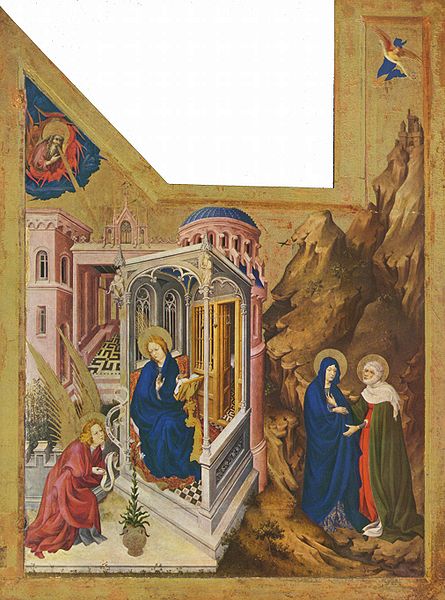Melchior Broederlam was one of the earliest Early Netherlandish painters to whom surviving works can be confidently attributed. He worked mostly for Philip the Bold, Duke of Burgundy, and is documented from 1381 to 1409. Although only a single large pair of panel paintings can confidently be attributed to him, no history of Western painting can neglect his contribution.
Melchior Broederlam, Annunciation and Visitation (1393–1399), left panel of a pair; (Dijon, Musée des Beaux-Arts)
The right panel: Presentation of Jesus and the Flight into Egypt. Each panel, including the frame, is 167cm high and 125cm wide.
Early Netherlandish painting
Early Netherlandish painting is the body of work by artists active in the Burgundian and Habsburg Netherlands during the 15th- and 16th-century Northern Renaissance period, once known as the Flemish Primitives. It flourished especially in the cities of Bruges, Ghent, Mechelen, Leuven, Tournai and Brussels, all in present-day Belgium. The period begins approximately with Robert Campin and Jan van Eyck in the 1420s and lasts at least until the death of Gerard David in 1523, although many scholars extend it to the start of the Dutch Revolt in 1566 or 1568–Max J. Friedländer's acclaimed surveys run through Pieter Bruegel the Elder. Early Netherlandish painting coincides with the Early and High Italian Renaissance, but the early period is seen as an independent artistic evolution, separate from the Renaissance humanism that characterised developments in Italy. Beginning in the 1490s, as increasing numbers of Netherlandish and other Northern painters traveled to Italy, Renaissance ideals and painting styles were incorporated into northern painting. As a result, Early Netherlandish painters are often categorised as belonging to both the Northern Renaissance and the Late or International Gothic.

Rogier van der Weyden, The Descent from the Cross, c. 1435, Museo del Prado, Madrid
Jan van Eyck, The Arnolfini Portrait, 1434, National Gallery, London
The Ghent Altarpiece, completed in 1432 by Hubert and Jan van Eyck. This polyptych and the Turin-Milan Hours are generally seen as the first major works of the Early Netherlandish period.
Hieronymus Bosch, The Garden of Earthly Delights, c. 1490–1510. Museo del Prado, Madrid. Art historians are divided as to whether the central panel was intended as a moral warning or as a panorama of paradise lost.






